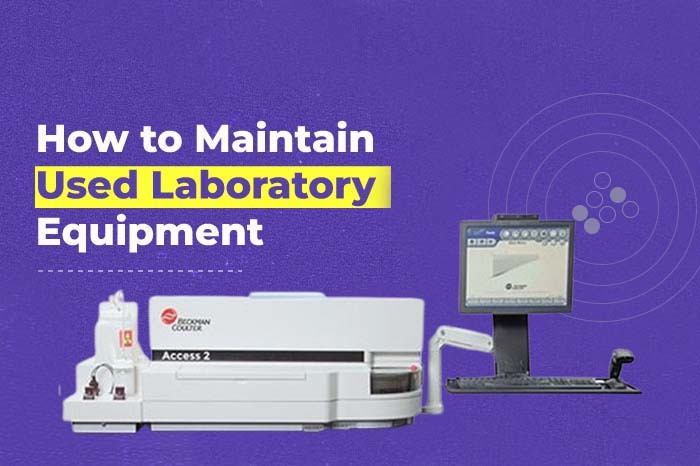In the fast-paced world of scientific research and experimentation, maintaining used laboratory equipment is essential for ensuring accurate results and prolonging the lifespan of valuable assets. Whether you’re a seasoned lab technician or a novice researcher, implementing a comprehensive maintenance routine is crucial for optimal performance and safety. Let’sexplore effective strategies and best practices for maintaining used laboratory equipment.
Training
Training plays a pivotal role in ensuring that laboratory staff are equipped with the necessary knowledge and skills to maintain equipment effectively.
The Manual
One of the first steps in maintaining laboratory equipment is to familiarize yourself with the manufacturer’s manual. The manual provides valuable insights into proper operation, maintenance procedures, and troubleshooting techniques specific to your equipment. Take the time to thoroughly read and understand the manual to ensure you’re following the manufacturer’s recommendations for optimal performance and longevity.
In-Person Training
In addition to reading the manual, consider seeking in-person training from qualified professionals or attending workshops and seminars on laboratory equipment maintenance. Hands-on training allows you to gain practical experience and learn valuable tips and tricks from experts in the field. Take advantage of these opportunities to enhance your knowledge and skills in equipment maintenance.

Regular Training Refreshers
To stay up-to-date with the latest advancements in laboratory equipment maintenance, participate in regular training refreshers or continuing education courses. As technology evolves and new equipment is introduced to the market, ongoing training ensures you’re equipped with the knowledge and skills needed to effectively maintain and troubleshoot a wide range of laboratory instruments.
Routine Maintenance
Cleaning
Regular cleaning is essential for preventing contamination and maintaining the accuracy and reliability of your laboratory equipment. Develop a cleaning schedule that includes daily, weekly, and monthly tasks, such as wiping down surfaces, disinfecting components, and removing debris. Use appropriate cleaning agents and techniques recommended by the manufacturer to avoid damage to sensitive equipment.
Inspections
Perform routine inspections of your laboratory equipment to identify signs of wear, damage, or malfunction. Check for loose or damaged components, unusual noises or vibrations, and irregularities in performance. Address any issues promptly to prevent further damage and ensure the continued functionality of your equipment.
Calibration
Calibration is critical for ensuring the accuracy and precision of your laboratory instruments. Develop a calibration schedule based on the manufacturer’s recommendations and regulatory requirements. Keep detailed records of calibration activities, including dates, results, and any adjustments made. Regular calibration helps maintain the integrity of your data and ensures compliance with quality standards.
Maintain a Log
Keep a comprehensive log of all maintenance activities performed on your laboratory equipment. Document details such as maintenance tasks, dates, technician’s name, and any observations or issues encountered. Maintaining a detailed maintenance log not only helps track the history of your equipment but also provides valuable insights for troubleshooting and future maintenance planning.
Repairs
Inevitably, your laboratory equipment may require repairs due to normal wear and tear or unexpected malfunctions. When issues arise, address them promptly to minimize downtime and prevent further damage. Consult the manufacturer’s manual or seek assistance from qualified technicians for complex repairs. Keep a list of trusted repair vendors or service providers to quickly resolve equipment issues when needed.
Refurbishing
Consider investing in refurbishment services to extend the lifespan and improve the performance of aging laboratory equipment. Refurbishing involves replacing worn or outdated components, upgrading software, and conducting thorough testing to ensure optimal functionality. By refurbishing your equipment, you can maximize efficiency and reliability without the need for costly replacements.
Tool Kits
Equip your laboratory with essential tool kits and maintenance supplies to facilitate routine upkeep and minor repairs. Invest in high-quality tools specifically designed for laboratory equipment maintenance, such as screwdrivers, wrenches, and multimeters. Having the right tools on hand allows you to quickly address maintenance tasks and minimize disruptions to your workflow.
Utilize Technology
Leverage technology to streamline your laboratory equipment maintenance efforts. Implement asset management software or maintenance tracking systems to automate maintenance schedules, track equipment status, and generate maintenance reports. These tools provide real-time insights into your equipment’s health and performance, allowing you to proactively address issues and optimize maintenance workflows.
Product Technician
Consult with the product technician or customer support team for guidance on laboratory equipment maintenance. They can provide valuable expertise and troubleshooting assistance to resolve issues and ensure the proper operation of your equipment. Establishing a good relationship with the manufacturer’s support team can be invaluable for maintaining the reliability and performance of your laboratory instruments.
Conclusion
In conclusion,maintaining used laboratory equipment is crucial for ensuring accuracy, reliability, and safety in scientific research and experimentation. By implementing a comprehensive maintenance routine and following best practices, you can prolong the lifespan of your equipment, minimize downtime, and achieve optimal performance in your lab operations. From regular cleaning and inspections to calibration and refurbishment, each step plays a vital role in preserving the integrity of your laboratory instruments.


